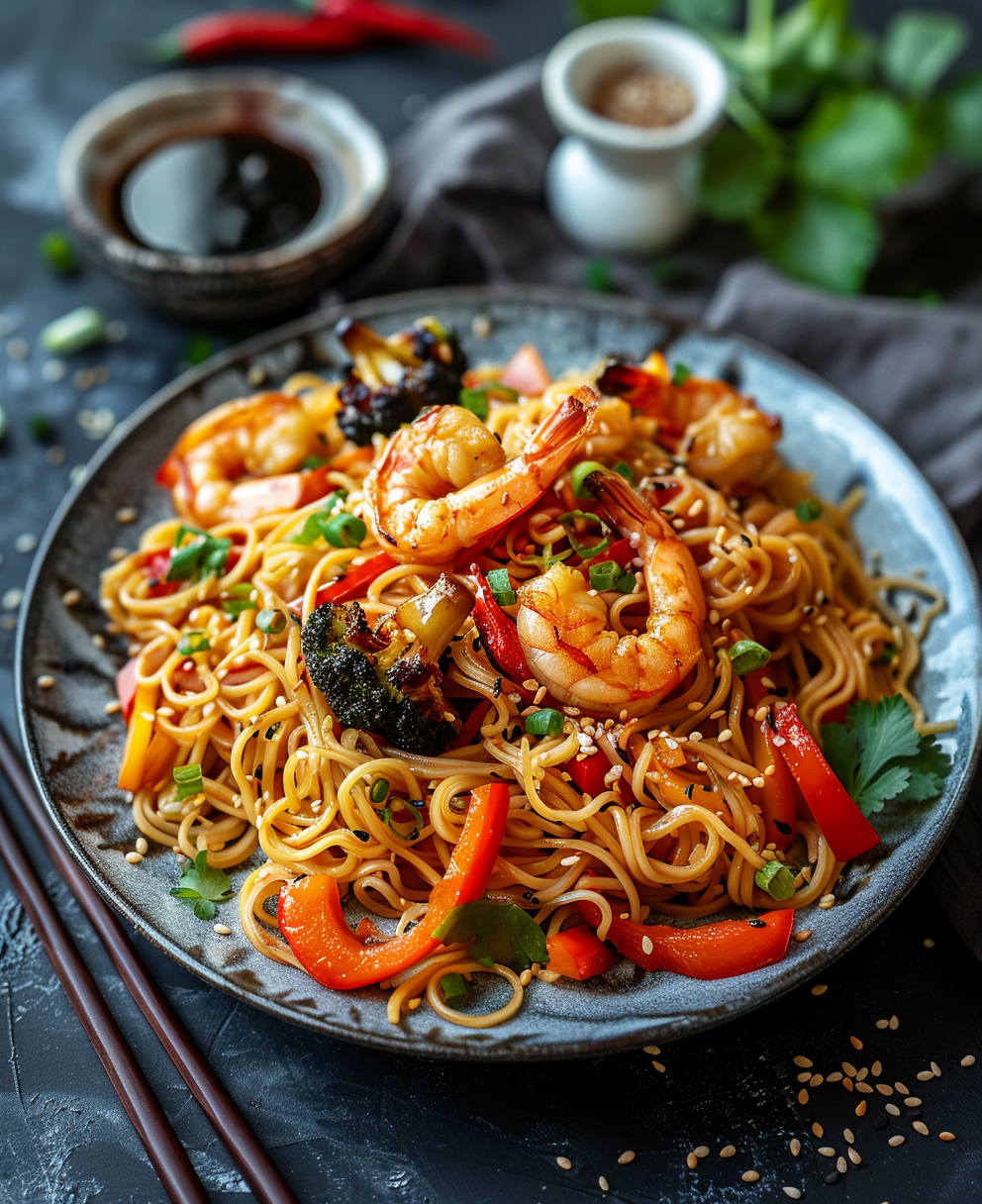
Why You’ll Love Making Hibachi Noodles at Home
I still remember the first time I tried hibachi noodles. The smoky aroma, the sizzle of the pan, and those perfectly cooked noodles felt like magic. Since then, I’ve been hooked. What if I told you that you can recreate that same experience in your own kitchen? With this hibachi noodles recipe, you’ll learn how to bring restaurant-quality flavors to your dinner table. It’s easier than you think.
Hibachi noodles are a staple in Japanese-inspired cuisine. They’re stir-fried to perfection and often served alongside grilled meats and veggies. The dish is a crowd-pleaser because it’s flavorful, satisfying, and versatile. Whether you’re cooking for yourself or hosting a dinner party, this recipe will guide you step-by-step to make noodles just like your favorite hibachi spot.
The Basics of Hibachi Noodles
Hibachi noodles are more than just a side dish—they’re the heart of a hibachi-style meal. These noodles soak up all the savory flavors from sauces and seasonings while pairing beautifully with proteins like chicken, shrimp, or beef. One of the reasons people love them is their simplicity. You don’t need fancy tools or exotic ingredients to make them shine.
A common question I hear is: What kind of noodle do they use at hibachi? Most restaurants use yakisoba noodles, which are chewy and slightly springy. If you can’t find yakisoba, lo mein noodles work just as well. Both options cook quickly and hold up well to the bold flavors of the dish. Plus, you can customize the noodles to suit your taste—whether you prefer them soft or with a bit of bite.
Another reason hibachi noodles are so popular is their adaptability. Want to add extra veggies? Go for it. Need a vegetarian option? Swap out the meat for tofu or mushrooms. No matter what you choose, the result will be delicious. This flexibility makes it a go-to dish for busy weeknights or special occasions.
Key Ingredients for Authentic Flavor
To nail the authentic taste of hibachi noodles, you’ll need a few key ingredients. Don’t worry—most of them are pantry staples you probably already have. Here’s a quick rundown:
- Noodles: Yakisoba or lo mein noodles are ideal. Look for them in the international aisle of your grocery store.
- Veggies: Classic choices include onions, bell peppers, carrots, and broccoli. Feel free to mix and match based on what you have on hand.
- Protein: Chicken, shrimp, or steak are traditional picks. For a plant-based twist, try tofu or chickpeas.
- Sauces: Soy sauce, sesame oil, and a touch of garlic create the base flavor. Some recipes also call for a sweet element like brown sugar or mirin.
- Seasoning: A sprinkle of hibachi seasoning elevates the dish. Look for blends online or make your own using salt, pepper, garlic powder, and ginger.
If you’ve ever wondered, What sauce is used in hibachi noodles?, the answer lies in a simple combination of soy sauce, sesame oil, and a hint of sweetness. Some places even add a splash of orange juice for a citrusy kick, which gives those famous “orange noodles” their bright flavor. Experimenting with these elements lets you tailor the dish to your liking.
One tip I swear by is to prep everything before you start cooking. Hibachi-style dishes come together fast, so having your ingredients chopped and ready ensures a smooth process. Trust me—your future self will thank you when dinner is on the table in under 30 minutes.
As you dive into this hibachi noodles recipe, keep in mind that the real secret is in the details. From the type of noodle you choose to the balance of sauces and seasonings, every decision shapes the final result. And the best part? You get to enjoy the fruits of your labor without leaving home.
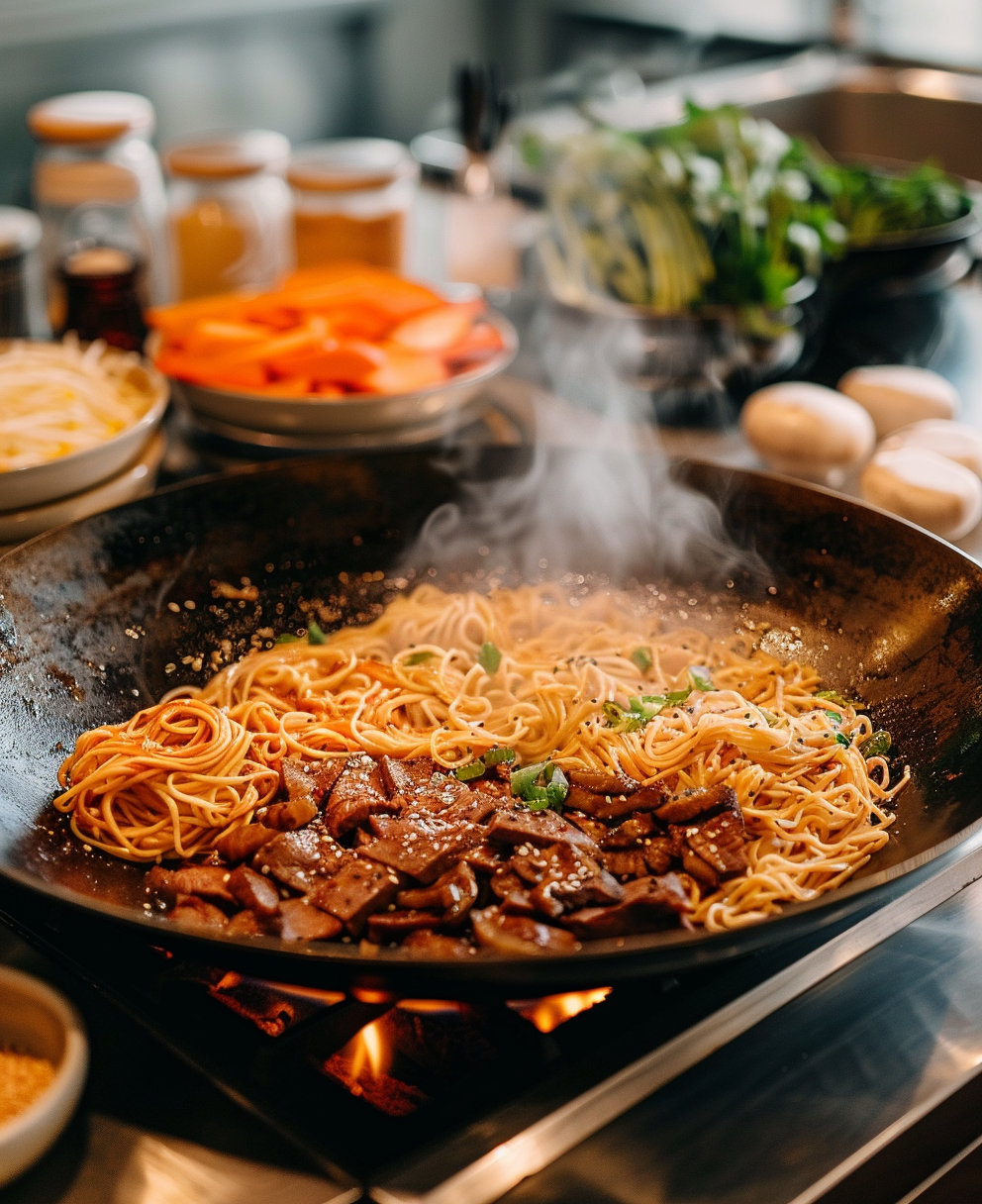
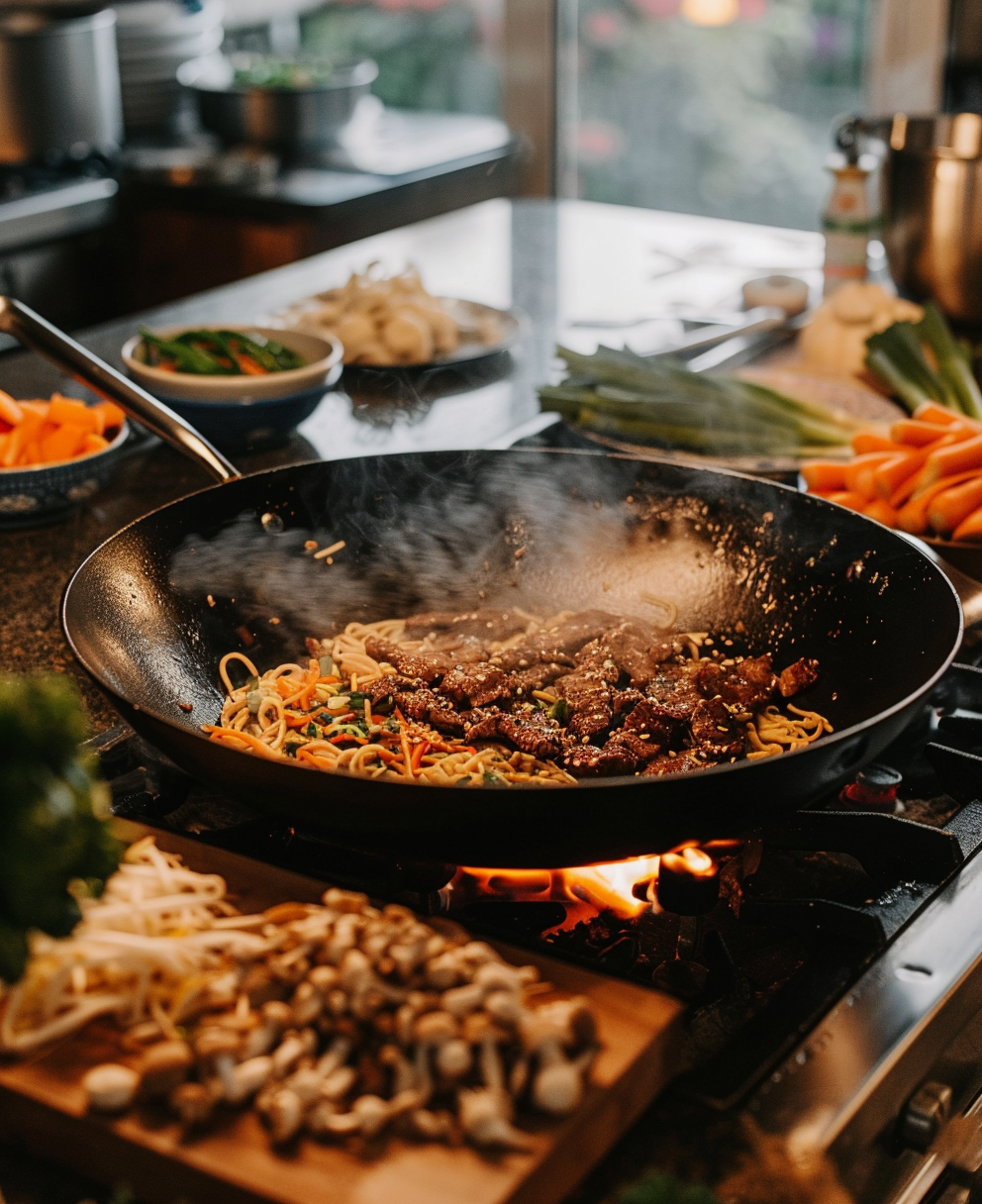
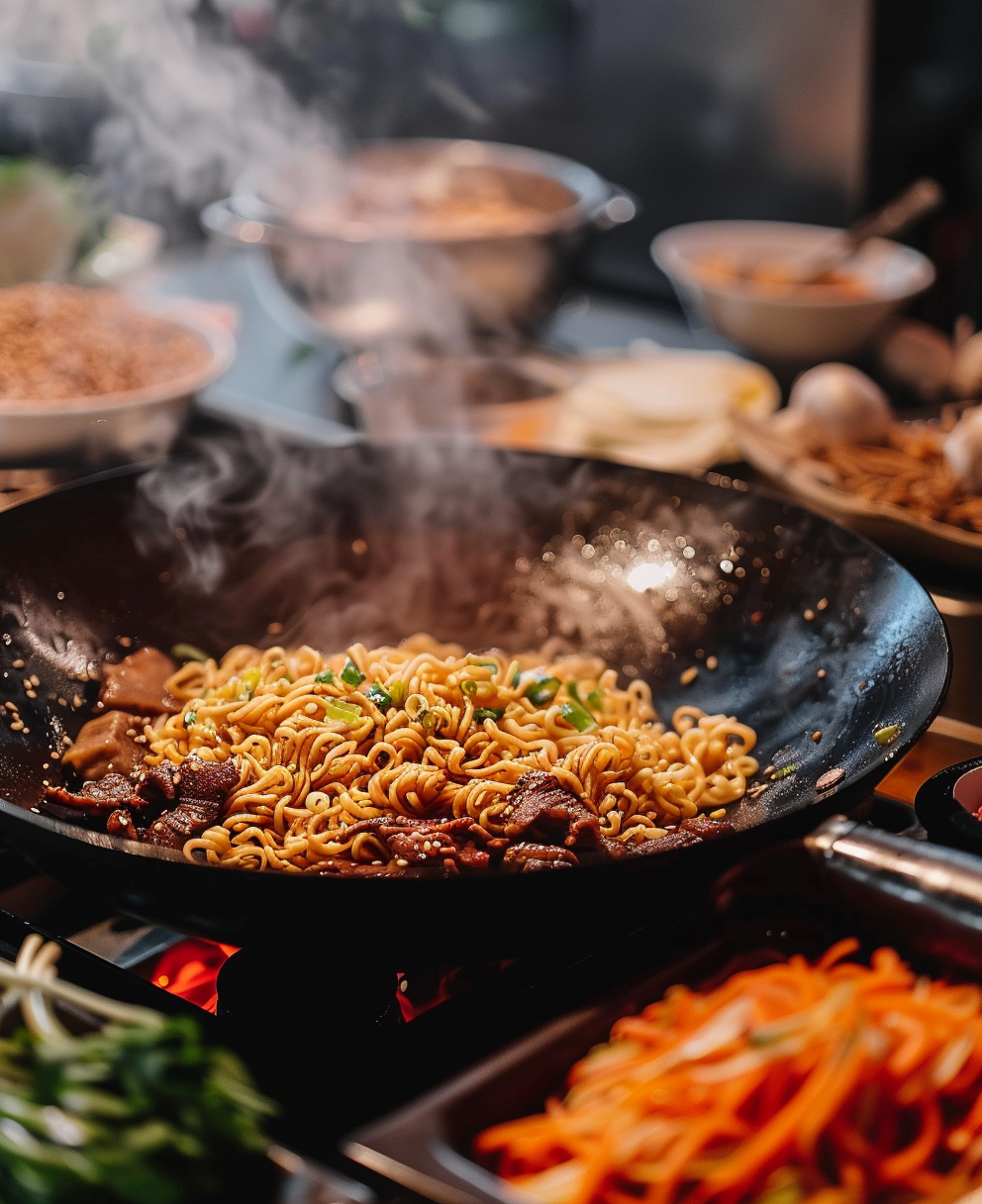
Alright, now that we’ve covered the basics and key ingredients, let’s roll up our sleeves and get into the nitty-gritty of making your hibachi noodles recipe shine. I’ll walk you through each step with tips and tricks to ensure your dish turns out as good as—or dare I say better than—your favorite hibachi spot. By the way, if you’re a fan of creamy pasta dishes, you might enjoy pairing this with my To Die For Fettuccine Alfredo. Trust me, it’s a game-changer.
Step 1 – Choosing and Cooking the Noodles
Here’s the thing about noodles: they’re the backbone of this dish. Get them wrong, and everything else feels off. That’s why selecting the right type is crucial. As I mentioned earlier, yakisoba noodles are the gold standard for hibachi-style cooking. They have just the right texture—chewy but not mushy—and hold up beautifully when tossed in sauces. If you can’t find yakisoba, don’t stress. Lo mein noodles are an excellent alternative, though they tend to be a bit softer. Funny enough, I once tried making this dish with gluten-free lasagna noodles from this recipe, and while unconventional, it worked surprisingly well for a low-carb twist.
When cooking your noodles, timing is everything. Overcooked noodles turn into a sticky mess, and undercooked ones feel too firm. Follow the package instructions, but start tasting them a minute or two before the suggested time. You want them al dente—firm to the bite but cooked through. Once they’re done, rinse them under cold water to stop the cooking process. This also removes excess starch, which helps prevent sticking later on. Pro tip: toss them with a tiny bit of sesame oil after rinsing to keep them slick and separate.
Now, let’s talk about those famous orange noodles at hibachi. Ever wondered what makes them so vibrant and flavorful? It’s all about the seasoning sauce. Most places use a blend of soy sauce, sugar, and sometimes a splash of orange juice or zest to give the noodles their signature tang. The color comes from a mix of natural ingredients like turmeric or paprika—not artificial dyes. So, if you’re aiming for that restaurant-style look and taste, don’t skip this step.
Step 2 – Making the Sauce
The sauce is where the magic happens. Seriously, without a stellar sauce, even the best noodles and veggies won’t save your dish. Lucky for you, whipping up a hibachi-style sauce is easier than you think. Start with a base of soy sauce—it’s salty, savory, and forms the foundation of most Asian-inspired sauces. Add a drizzle of sesame oil for nutty depth, minced garlic for punch, and fresh ginger for a zesty kick. A pinch of brown sugar balances the flavors, while a splash of rice vinegar adds brightness.
For those wondering What sauce is used in hibachi noodles?, this simple combination is your answer. But here’s a little secret: every chef tweaks it slightly to make it their own. Some add mirin for sweetness, others throw in chili flakes for heat. Personally, I love squeezing in a bit of orange juice—it gives the noodles that unmistakable citrusy flair. If you’re watching your sodium intake, swap regular soy sauce for low-sodium or tamari. You won’t lose any flavor, I promise.
One more thing—don’t overcomplicate it. This sauce isn’t meant to be fussy. In fact, simplicity is its strength. Think of it as the yin to your noodles’ yang. Speaking of noodles, did you know you can slow-cook chicken and noodles in a crockpot? Check out this recipe for a cozy, hands-off meal idea. It’s perfect for days when you want comfort food without the fuss.
Step 3 – Adding Seasoning and Flavor
Alright, let’s spice things up—literally. Hibachi noodles wouldn’t be the same without their bold seasoning blend. The question What seasoning is on hibachi? gets asked a lot, and the answer varies depending on who you ask. However, there are a few staples you’ll find in almost every version. Garlic powder and ginger are must-haves, adding warmth and complexity. Soy sauce contributes saltiness, while sesame seeds bring a subtle crunch and aroma.
Some chefs take it further by incorporating chili flakes or cayenne pepper for a fiery edge. Others sprinkle in a bit of black pepper or smoked paprika for extra oomph. My go-to blend includes garlic powder, ginger, a touch of onion powder, and a dash of white pepper. It’s simple yet packs a punch. If you’re feeling adventurous, try making your own seasoning mix. Trust me, it’s worth the effort.
Oh, and here’s a fun digression—I once forgot to buy pre-made hibachi seasoning for a dinner party. Instead of panicking, I grabbed whatever spices I had in my pantry and improvised. Turns out, a little creativity goes a long way. Just remember to taste as you go; adjusting seasonings along the way ensures balance. And hey, if you’re looking to experiment with homemade pasta, this guide to homemade lasagna noodles might inspire you to try something new.
Finally, let’s talk about how to layer these flavors effectively. After tossing your cooked noodles in the sauce, sprinkle your seasoning blend evenly over the top. Give everything a good stir to distribute the spices, then let the mixture sit for a minute or two. This allows the flavors to meld together. Don’t rush this part—it’s what separates mediocre noodles from truly memorable ones.
Before wrapping up this section, I want to emphasize one last point: confidence is key. Cooking hibachi-style dishes is all about trusting your instincts. Adjust the seasoning, tweak the sauce, and make it yours. Whether you’re serving it alongside grilled steak or enjoying it as a standalone meal, your hibachi noodles recipe will leave everyone craving seconds.
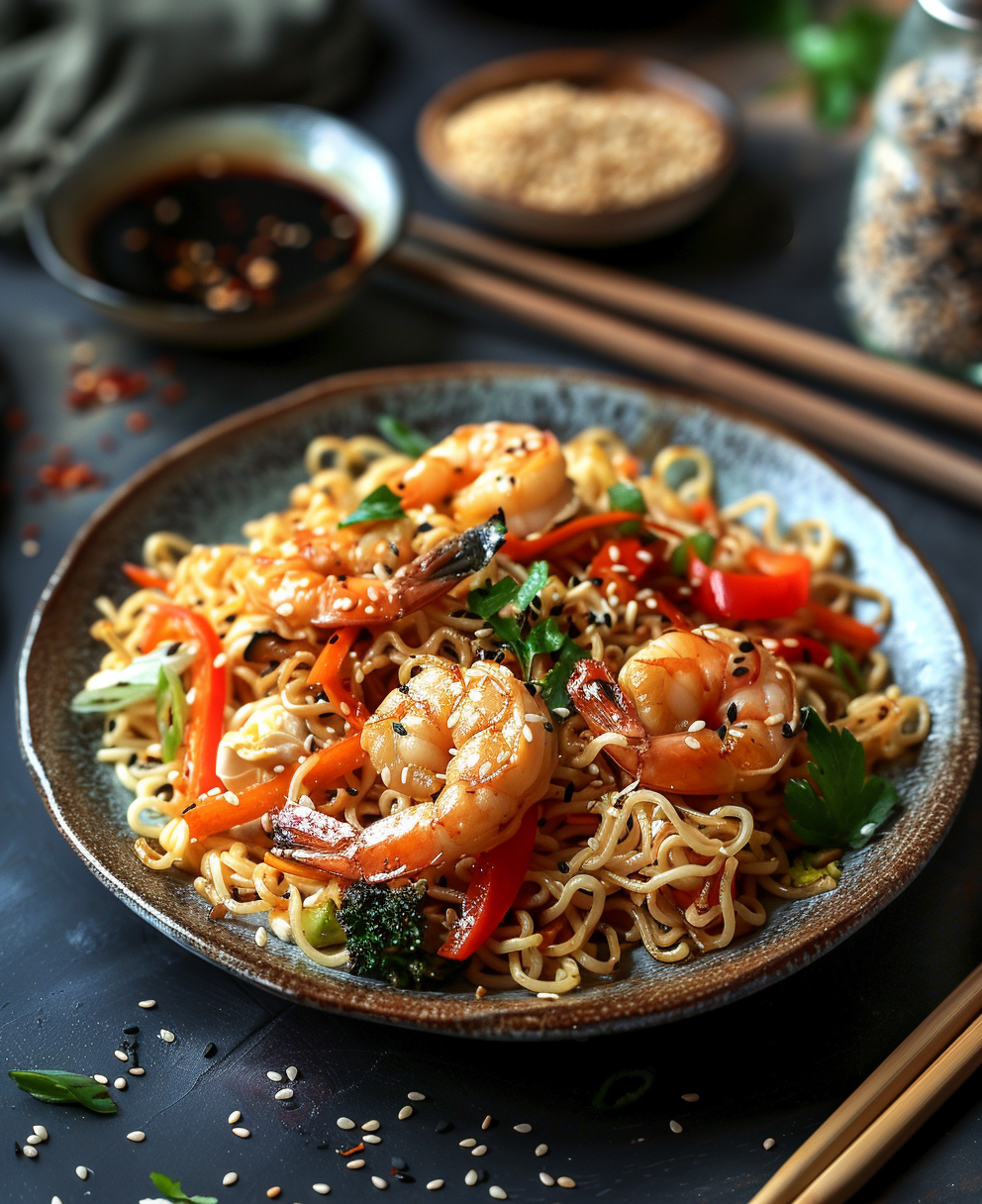
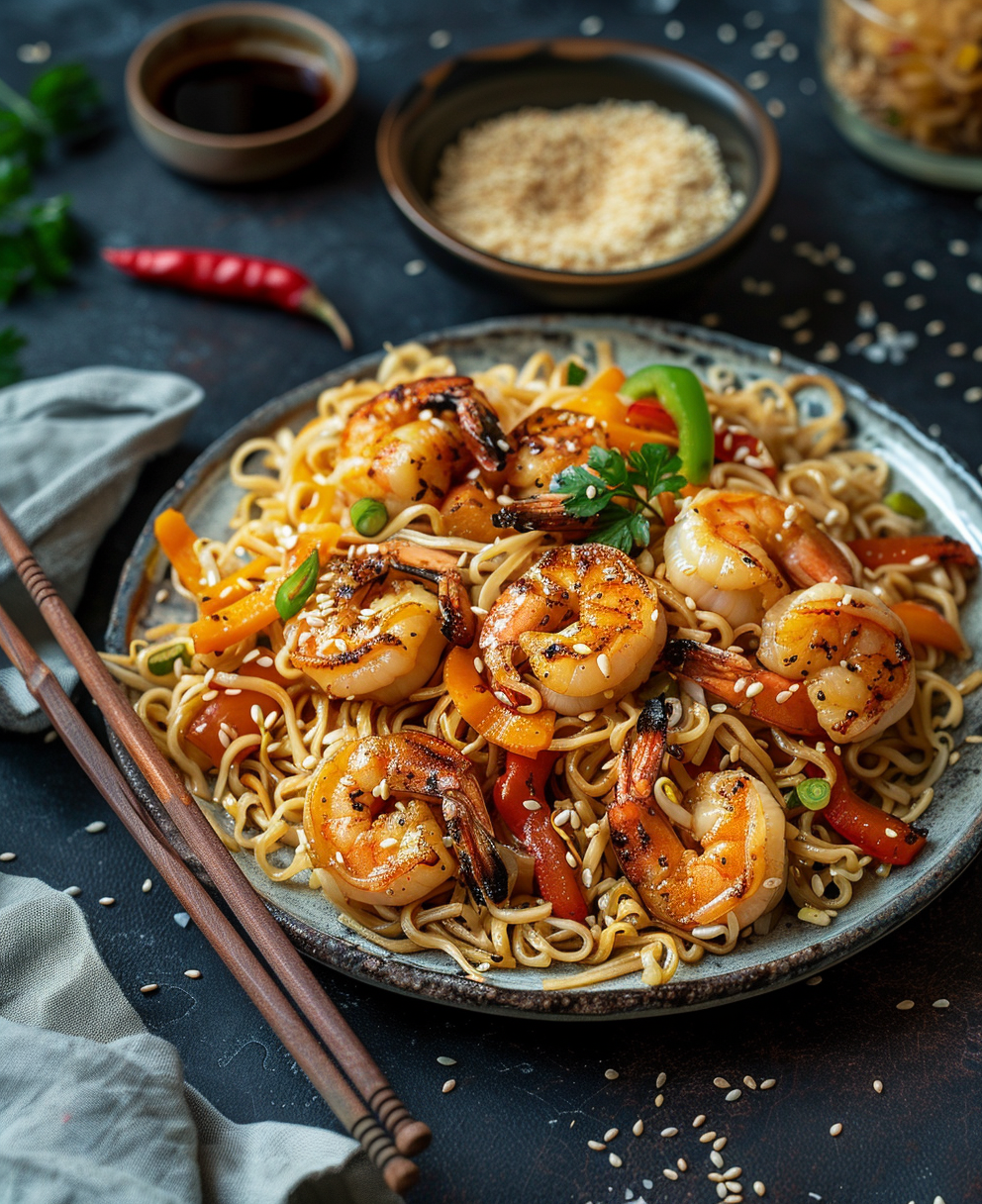
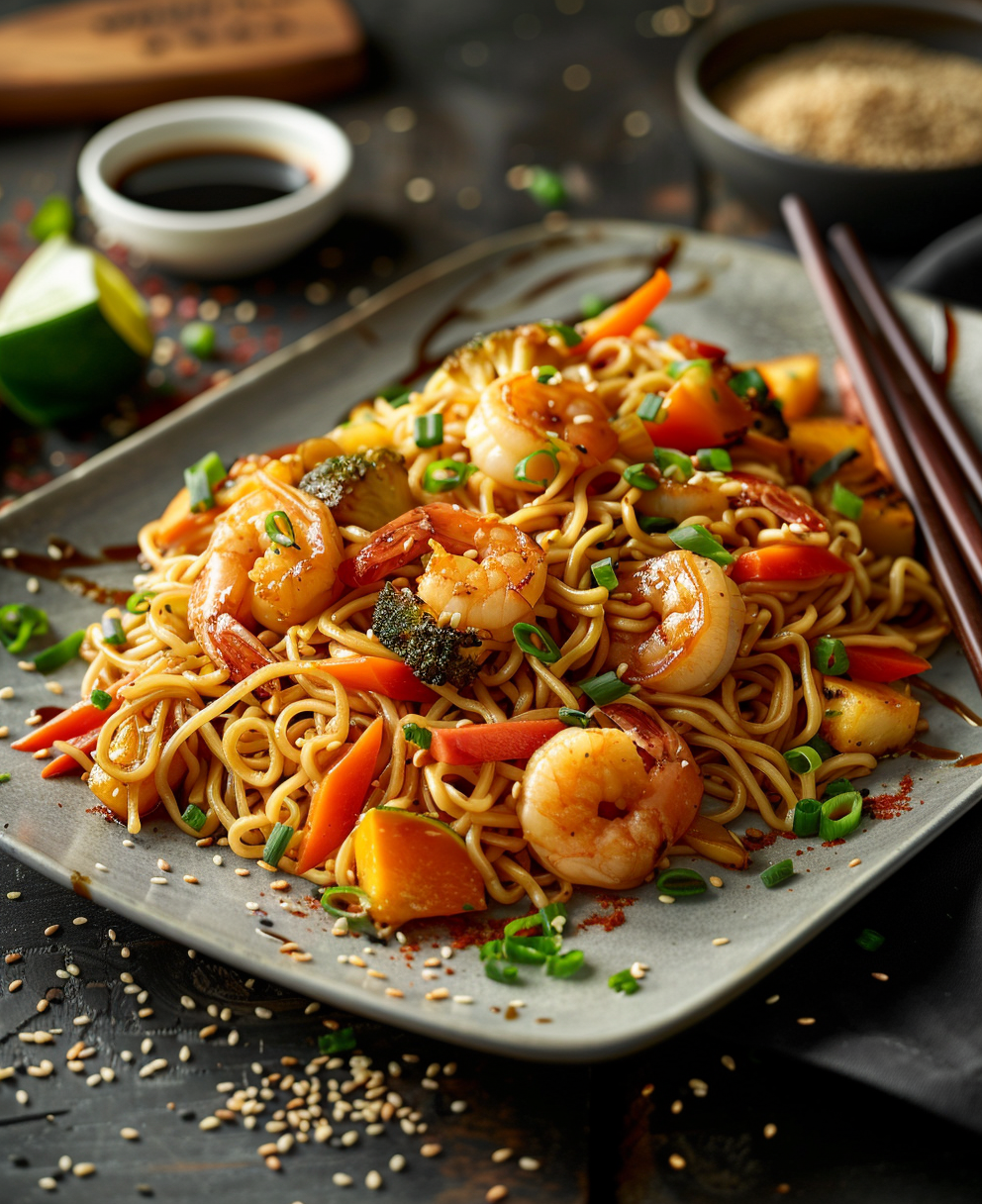
Cooking Techniques for Perfect Hibach Noodles
Let’s get to the heart of it—how do you actually cook these noodles so they taste like they’ve been kissed by a hibachi grill? It’s all about technique. If you’ve ever watched a hibachi chef work their magic, you know the key is high heat and quick movements. The good news? You don’t need a giant teppanyaki grill to pull this off at home.
Start by cranking up your stove to its highest setting. A well-seasoned cast-iron skillet or a large stainless steel pan works wonders here. The goal is to mimic that intense heat chefs use to sear ingredients quickly, locking in flavor and texture. Pro tip: preheat your pan for a minute or two before adding oil. This ensures everything hits a screaming hot surface, which is crucial for that signature smoky char.
Once your pan is ready, toss in a neutral oil with a high smoke point, like vegetable or peanut oil. Swirl it around to coat the bottom evenly. Then, add your protein first—whether it’s chicken, shrimp, tofu, or even thinly sliced beef. Cook it in batches if needed; overcrowding the pan will steam your food instead of searing it. Funny enough, I once tried cooking everything at once because I was in a rush. Let’s just say my noodles ended up soggy, and my patience was tested.
After your protein is nicely browned, set it aside and move on to the veggies. Bell peppers, onions, broccoli, and carrots are classics, but feel free to experiment. Slice them thinly so they cook fast without turning mushy. Toss them into the pan and stir frequently. You want them tender-crisp, not limp. Think vibrant colors and a bit of crunch. Oh, and don’t forget to season them lightly as they cook—it builds layers of flavor.
Now comes the fun part: combining everything. Add your cooked noodles back into the pan along with your protein and veggies. Pour in your sauce—you know, the one we talked about earlier—and give it all a good toss. The heat will bring everything together, coating the noodles and ingredients evenly. Let it sizzle for a minute or two, then taste and adjust the seasoning if needed. By the way, if you’re looking to expand your noodle repertoire, check out this collection of noodle recipes. You might discover a new favorite dish while you’re at it.
Presentation Tips for That Restaurant-Quality Finish
Here’s the deal: presentation matters. Even the most delicious meal can fall flat if it looks like a pile of leftovers. Lucky for you, making your hibachi noodles look Instagram-worthy is easier than you think. First, plate them strategically. Use tongs or chopsticks to create height—a little mountain of noodles always looks impressive. Scatter some sesame seeds or chopped green onions on top for color and texture. Trust me, those tiny details make a big difference.
If you really want to go the extra mile, serve your noodles on a sizzling hot plate. Yes, it’s an extra step, but hear me out. Preheat a cast-iron skillet in the oven, then carefully transfer your noodles onto it right before serving. The residual heat creates that satisfying sizzle, just like at a restaurant. Bonus points if you drizzle a bit of sesame oil around the edges for added aroma.
Another pro tip: pair your noodles with complementary sides. A simple cucumber salad or steamed edamame adds freshness and balance to the meal. And hey, if you’re feeling fancy, throw in a few slices of avocado for creaminess. It’s unexpected but totally works.
Frequently Asked Questions About Hibachi Noodles Recipe
- What kind of noodle do they use at hibachi?
Most hibachi restaurants use yakisoba noodles, which have a chewy texture and hold up well to sauces. Lo mein noodles are a great alternative if you can’t find yakisoba. Both options are widely available in grocery stores. - What sauce is used in hibachi noodles?
The sauce typically includes soy sauce, sesame oil, garlic, ginger, and a touch of sweetness from brown sugar or mirin. Some variations include orange juice for a citrusy twist. Keep it simple, and tweak it to match your taste buds. - What seasoning is on hibachi?
Common seasonings include garlic powder, ginger, onion powder, white pepper, and sesame seeds. Some chefs add chili flakes or smoked paprika for extra kick. Feel free to mix and match to create your own blend. - What are the orange noodles at hibachi?
Those vibrant orange noodles often get their color from turmeric or paprika, combined with a tangy-sweet sauce made from soy sauce, sugar, and sometimes orange juice. It’s all about balancing flavors and colors. - Can I make hibachi noodles vegetarian?
Absolutely! Swap the meat for tofu, chickpeas, or mushrooms. Load up on veggies like zucchini, snap peas, or spinach for added nutrition and flavor. The dish will still be hearty and satisfying. - How do I prevent my noodles from sticking?
Rinse them under cold water after cooking to remove excess starch. Toss them with a small amount of sesame oil to keep them slick. Stirring frequently while cooking also helps prevent clumping. - What’s the best pan to use for hibachi-style cooking?
A cast-iron skillet or stainless steel pan is ideal due to its ability to retain heat. Nonstick pans can work too, but they won’t give you the same level of browning or char. - Can I prep this dish ahead of time?
You can chop veggies and cook noodles in advance, but assemble and cook the dish just before serving. Stir-fries lose their texture if reheated, so fresh is always best. - Is there a gluten-free option for hibachi noodles?
Yes! Try using rice noodles or gluten-free yakisoba. Substitute tamari for soy sauce to keep the dish entirely gluten-free. Adjust cooking times based on the noodle type. - How can I make my noodles spicier?
Add red pepper flakes, sriracha, or a dash of cayenne pepper to the sauce. For a subtler heat, grate fresh ginger into the mix. Start small and adjust to your spice tolerance.
Here’s the thing about cooking—it’s supposed to be fun. Don’t stress over perfection. Whether you nail the recipe on your first try or tweak it until it feels just right, the process should leave you smiling. So grab your ingredients, fire up the stove, and give this hibachi noodles recipe a shot. Once you’ve mastered it, share your creation with friends or family. Better yet, snap a photo and tag us—we’d love to see what you come up with!

Hibachi Noodles Recipe
Ingredients
Equipment
Method
- Choose and cook the noodles according to package instructions, ensuring they are al dente. Rinse under cold water.
- Make the sauce by combining soy sauce, sesame oil, minced garlic, grated ginger, brown sugar, and a splash of rice vinegar in a bowl.
- Heat a cast-iron skillet or stainless steel pan over high heat and add neutral oil.
- If using, cook your choice of protein first, then set it aside.
- Add thinly sliced veggies to the pan and stir-fry until tender-crisp.
- Combine the cooked noodles, protein, and veggies in the pan and pour in the sauce.
- Toss everything together until well mixed and heated through. Adjust seasonings as needed.
- Serve, garnished with sesame seeds or chopped green onions if desired.
